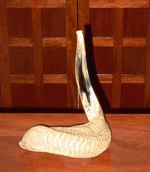The Disciple Newsletter
A Newsletter for the Serious Religious Christian
By H. Bruce Stokes, Ph.D.
Doctrinal Distinctives of the DiscipleCenter
The DiscipleCenter is distinctive in several areas of doctrine due to its connection to Historic Christianity and Messianic Judaism. These distinctions may be seen in the following areas of Theology.
1. The Relationship of the Torah and the Gospel The traditional view of Christianity is that the Gospel has replaced the Law as a result of Calvary. We understand the Gospel as the Good news that the substance of what the Law promised is found in the Messiah, and that the New Covenant is presently emerging and the former is preparing to be removed. Therefore, there is an overlap between the covenants in application from the time of the first coming of the messiah and the return. The completion will take place after the Kingdom period at the return of Jesus.
2. The Body of the Messiah as containing both Jew and Gentile The traditional view is that the Church has replaced Israel because of their unbelief. We hold that the believing Gentiles (Christians) are grafted into the root, and the commonwealth of Israel in the body of the Messiah. Just as there is a large unbelieving part of Israel and a believing remnant according to God's election, so there is a remnant of believing Gentiles in the Church among a large group of unbelievers. The Body of the Messiah is to include believing Jews, as Jews, who are to be a light to the nations (Gentiles) by their observance of Torah. It also includes Gentile disciples from every nation who remain Gentiles but become a basis of envy to unbelieving Israel as these Gentiles demonstrate the spirit of Torah by the Sprit of God in them. These two groups of believers are "One" in the Messiah but they are not the same. As a husband and wife remain male and female and in distinctive roles, yet are one flesh, so the Jew and Gentile in the Body of the Messiah show the unity of the one new Man, not by sameness but by the unity of the Spirit and Truth.
3. The Purpose of the Law The traditional view is that the purpose of the Law was intended to save but was a failure. The Bible never speaks of a covenant of works established by God for the salvation of people. Salvation has always been by Grace through faith. The Law was given to Israel, after they were redeemed by the Hand of God, using the means and symbol of the Passover Lamb. The Law was given with several purposes in mind. It established the knowledge of sin and the commandments of Holiness and Goodness so that the people of God could glorify Him. It made a symbolic and behavioral distinction between Israel and the nations so that they could be a light to the nations. It pointed by shadow and symbol to the Messiah and all that He would fulfill as the One sent from God. These purposes are still unfolding and the teaching of the Law and appropriate obedience should continue until all is fulfilled.
4. The Times of the Gentiles and the Restoration of Israel The purpose of God regarding the partial “Blinding of Israel” until the “Times of the Gentiles” are fulfilled and the restoration of Israel may be connected to the Messianic Movement and the return of Israel as a nation to the Promised Land.
The Diaspora Model of Faith Community in Pluralistic American The shift in the United States from the Melting Pot to Pluralistic Paradigm has resulted in the marginalization of Christianity to the point that sociologists presently call post-Christian America. This has resulting in many Christians calling for a return to a Christian America using persuasion and political force. While we believe that persuasion is an import part of the Christian calling, we believe a Diaspora model of Christian Community is a more Biblical response to the present situation. This demands that the Christian Community develop its own distinctively Christian institutions (Family, Congregation, Schools) to serve our community needs so that we may engage in meaningful dialog with pluralistic America and that we can show the fruits of our doctrines in our own homes and families.
 |
Copyright© 2003-2007 HBStokes/The DiscipleCenter – All Rights Reserved
For technical questions/assistance with this site, please contact The Brookman Company